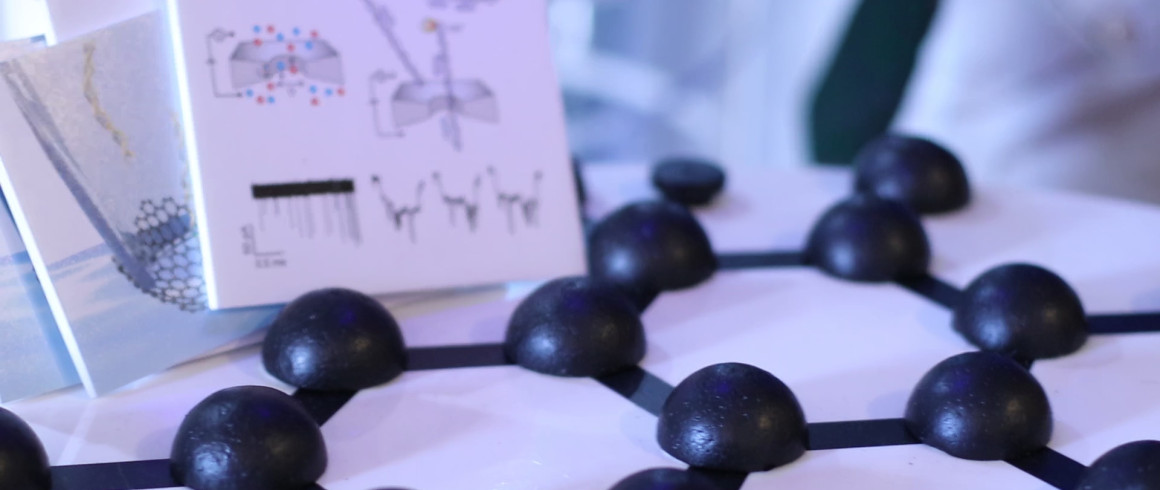Mind the Nano-Gap at the Royal Society Summer Exhibition
The University of Cambridge NanoDTC is taking part in the Royal Society’s Summer Science Exhibition this year.
The NanoDTC display, ‘Mind the Nano Gap’, demonstrates a range of ways in which nanotechnology can be applied for sensing and detection purposes. Two Pembroke graduate students, Shruti Sharma (2015), NanoDTC student, and Anna Gunnarsdottir (2016), a NanoDTC associate, are part of the exhibition team and explained what was on show.
What is the exhibition about?
The exhibition centers around nanotechnology, which allows us to concentrate on the nanoscale or the atomic level. The exhibition demonstrates how we can use different gaps in nano-materials as sensors, with applications in a number of fields, including physical sciences and the health sector. There are four stations: NanoPore sensing, Sensing in Flatland, NanoGap sensing, and Intelligent Toilet.
How can nanotech be applied for sensing?
We’re dealing with things that are smaller than the wavelength of light, and using nano-technology we can create tools that get around the issue of being able to see at such small scales. The exhibition uses a 2D material, Graphene, to sense properties such as molecules’ size, charge, and mass. Graphene is one of the thinnest available surfaces because it’s two-dimensional – it’s only one atom thick. Any perturbations are therefore easy to detect – they don’t get ‘lost’ in a thick material and small changes like oscillation are not absorbed. It makes for very sensitive systems that can be manipulated for use in specific tasks. NanoPore and Sensing in Flatland for example, demonstrate how disrupting the electronic field on graphene membrane can enable detection of molecular properties.
[auto-gallery]


 [/auto-gallery]
[/auto-gallery]
How has this been demonstrated within the exhibit?
Obviously we can’t demonstrate actual nanomaterials in the exhibition but we’ve put together some stations that represent what’s happening at the nanoscale. ‘Sensing in Flatland’ for example, is describing the principle of detecting charge and mass of molecules using graphene as a sensor. By introducing a molecule to a graphene membrane, it causes a disruption in the electron flow which tells us properties like molecular charge and mass when we observe the resulting frequency changes. NanoPore sensing – represented by putting a chain of tennis balls through a hole – demonstrates how deliberately-placed pores in a two-dimensional nanomaterial can detect the size of molecules passing through them. In the exhibit we are detecting how many tennis balls are in the chain.
A third part of the exhibition, NanoGap sensing, uses gold-nano particles and light to create a sensor. You place two gold nano-particles together and use light to induce oscillation of the electrons. It creates a strong electric field between the particles. Light doesn’t like to interact with matter, but when you concentrate light in a very small region you get a strong interaction in the gap between nano-particles, and it creates a localized electronic field. When you introduce a molecule into the gap – thereby introducing it to that electronic field - the bonds of the molecule vibrate and re-emit light on a different wavelength. Each molecule re-emits light on specific wavelengths, like a kind of molecular signature. By detecting the light that is emitted it tells you about the type of bonds and the type of atoms you have around these bonds.
Together these essentially represent the fact that you can apply nano-technology in a number of fields and in a number of ways. The molecules being detected could be hormones or proteins being measured by an intelligent toilet, for the purposes of effective healthcare – one of the applications we’ve included in the exhibit. Sensing isn’t the only use for Nano-technology – it has a lot of potential applications. It’s also key, for example, in semiconductor physics in which manipulation of bandgap in semi-conductors gives rise to a variety of new properties, one of which is precise emission of specific light color. Nano-technology allows us to further understand particle behavior, and test and prove theories.
Read more about the exhibition here
